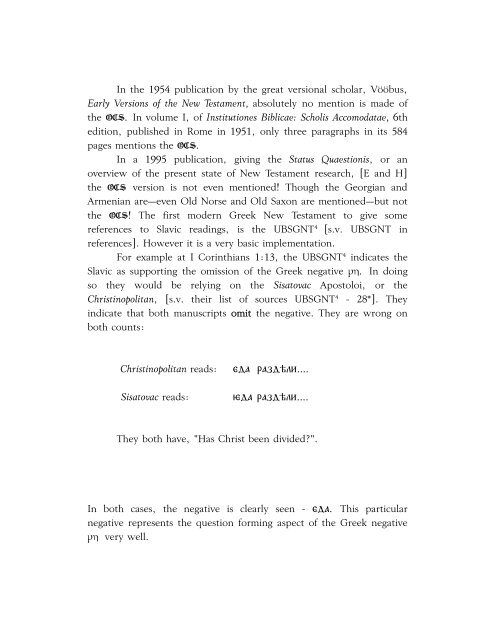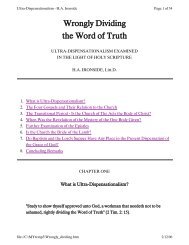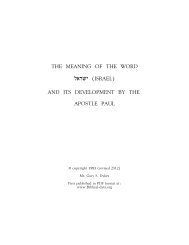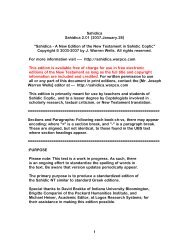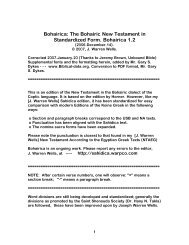OCS and the Greek New Testament - Biblical-data.org
OCS and the Greek New Testament - Biblical-data.org
OCS and the Greek New Testament - Biblical-data.org
Create successful ePaper yourself
Turn your PDF publications into a flip-book with our unique Google optimized e-Paper software.
In <strong>the</strong> 1954 publication by <strong>the</strong> great versional scholar, Vööbus,<br />
Early Versions of <strong>the</strong> <strong>New</strong> <strong>Testament</strong>, absolutely no mention is made of<br />
<strong>the</strong> Ú. In volume I, of Institutiones Biblicae: Scholis Accomo<strong>data</strong>e, 6th<br />
edition, published in Rome in 1951, only three paragraphs in its 584<br />
pages mentions <strong>the</strong> Ú.<br />
In a 1995 publication, giving <strong>the</strong> Status Quaestionis, or an<br />
overview of <strong>the</strong> present state of <strong>New</strong> <strong>Testament</strong> research, [E <strong>and</strong> H]<br />
<strong>the</strong> Ú version is not even mentioned! Though <strong>the</strong> Ge<strong>org</strong>ian <strong>and</strong><br />
Armenian are¯even Old Norse <strong>and</strong> Old Saxon are mentioned¯but not<br />
<strong>the</strong> Ú! The first modern <strong>Greek</strong> <strong>New</strong> <strong>Testament</strong> to give some<br />
references to Slavic readings, is <strong>the</strong> UBSGNT 4 [s.v. UBSGNT in<br />
references]. However it is a very basic implementation.<br />
For example at I Corinthians 1:13, <strong>the</strong> UBSGNT 4 indicates <strong>the</strong><br />
Slavic as supporting <strong>the</strong> omission of <strong>the</strong> <strong>Greek</strong> negative mh. In doing<br />
so <strong>the</strong>y would be relying on <strong>the</strong> Sisatovac Apostoloi, or <strong>the</strong><br />
Christinopolitan, [s.v. <strong>the</strong>ir list of sources UBSGNT 4 - 28*]. They<br />
indicate that both manuscripts omit <strong>the</strong> negative. They are wrong on<br />
both counts:<br />
Christinopolitan reads: Rda ra9dYlI....<br />
Sisatovac reads: Jda ra9dYlI....<br />
They both have, "Has Christ been divided?".<br />
In both cases, <strong>the</strong> negative is clearly seen - Rda. This particular<br />
negative represents <strong>the</strong> question forming aspect of <strong>the</strong> <strong>Greek</strong> negative<br />
mh very well.


